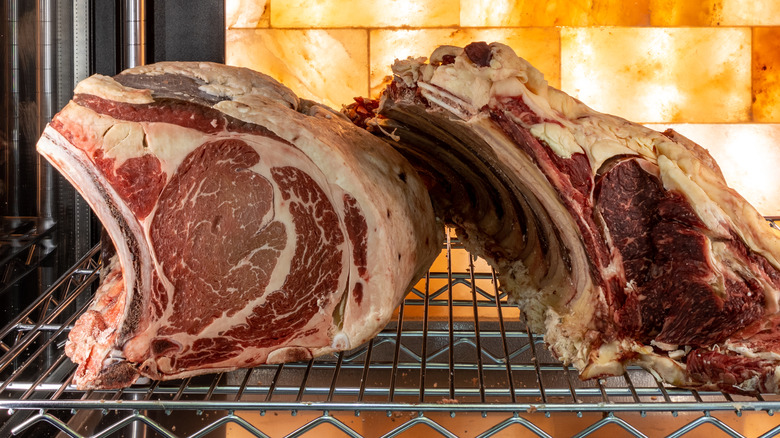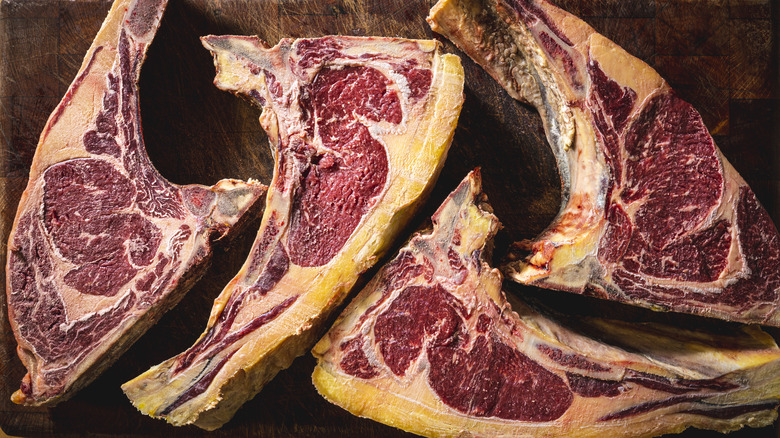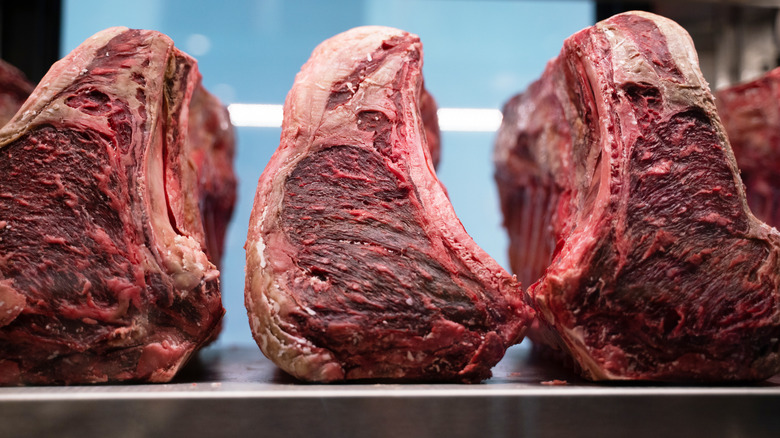The Tell-Tale Signs Your Dry-Aged Steak Is Ready To Devour
Elevating your home cooked beef to steakhouse quality is no easy task. According to chefs, restaurant steaks taste better due to several factors, like improved heat sources, ingredient quality, and not to mention preparation skill. However, that's not to say enhancing your beef isn't worth attempting, with an excellent technique being dry-aging. By resting steak in a specific climatic environment, the flavor intensifies, develops new savory notes, and the cut becomes more tender.
To achieve maximum potential, the process requires a minimum two weeks time, and it can be difficult to know when the beef's ready. You'll need to carefully use your senses, and look for a darkening in color, development of a crust, and reduction in size that can reach a third. Be wary of rotten aromas; if any are present, the beef isn't safe for consumption. And the same applies to darkly colored mold, although small amounts of lightly colored funk are permissible. Really though, it's best to trust a well-developed dry-aging system, backed by a daily counter. Carefully track your beef rest time, and you'll be best able to predict its state.
The duration of dry-aging impacts the flavor
The process of dry-aging is a complicated endeavor, involving a slow, yet steady transformation of beef. Determining the readiness based on external inspection is tricky, keep an eye on the day counter. Whenever the dry-aging is carried out properly, there'll be a large window of when the meat's good to eat.
Tenderizing effects occur two weeks in, which is the absolute minimum time worth the effort. Then at 21 days, the first visual distinction occurs; the fat darkens, and meat shrinks by 10% or so. However, the flavors really shine around a month in, which is considered an optimal aging duration. At this time, the steak will lose 15% of its weight, and start really develop rich and savory palate reminiscent of mushrooms. The funkiness becomes more apparent, the nuttiness increases, and blue-cheese-like notes appear around 45 days in. After this point, the bacteria-induced flavors may be off-putting to some diners due to their funky sharpness (the pungent cheesiness intensifies over time), and the steak will decrease by around 30% weight. Although the crust can turn nearly black as it ages, a butchered, ready-to-cook dry-aged steak may not appear as deeply red as its wet-aged counterpart.
It's important to note that the optimal aging timeframe is subjective; the mingling of the flavor and meat cut varies, as well as the preferences of the diner. So, to ascertain your dry-aged steak preferences, you'll want to sample different durations before selecting the best fit. Regardless of when you've deemed the steak ready to eat, note that dry-aged beef is a particularly tricky cut for grilling. After all, you wouldn't want all of your strenuous efforts to go to waste.
Dry-aging requires a carefully controlled environment
There's much more to dry-aging than simply laying beef in your fridge for extended periods. Steaks aged for under a week won't have a noticeable improvement in flavor. In fact, it'll likely be the opposite; meat in a home fridge will absorb off-tasting aromas of other foods. And before the aging pays off, unwanted bacteria will incite rotting. As a result, investing in a dedicated fridge complete with a ventilation setup is essential for the process.
It's the reason steakhouses transform standard beef with intricate aging facilities, involving controlled humidity, temperature, and air flow. The process occurs by way of enzymes in the meat, as well as bacteria from the aging environment. Clean the utilized fridge thoroughly before use, and avoid opening the door frequently. Consider even purposefully placing beneficial mold into the setup. Understanding the conditions before and during aging are key positive signs of edibility.
And once it's done, be extra vigilant with the emanating smells. Ensure there are no off-putting aromas, whether a touch sour, foul, or of anything that doesn't smell tasty. The aroma of prepared dry age beef should be akin to moldy cheeses; powerful, nutty, and complex, but always tempting to eat.


